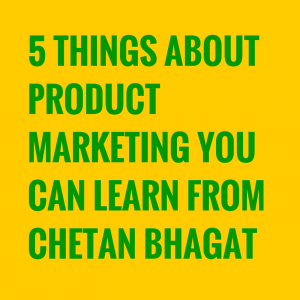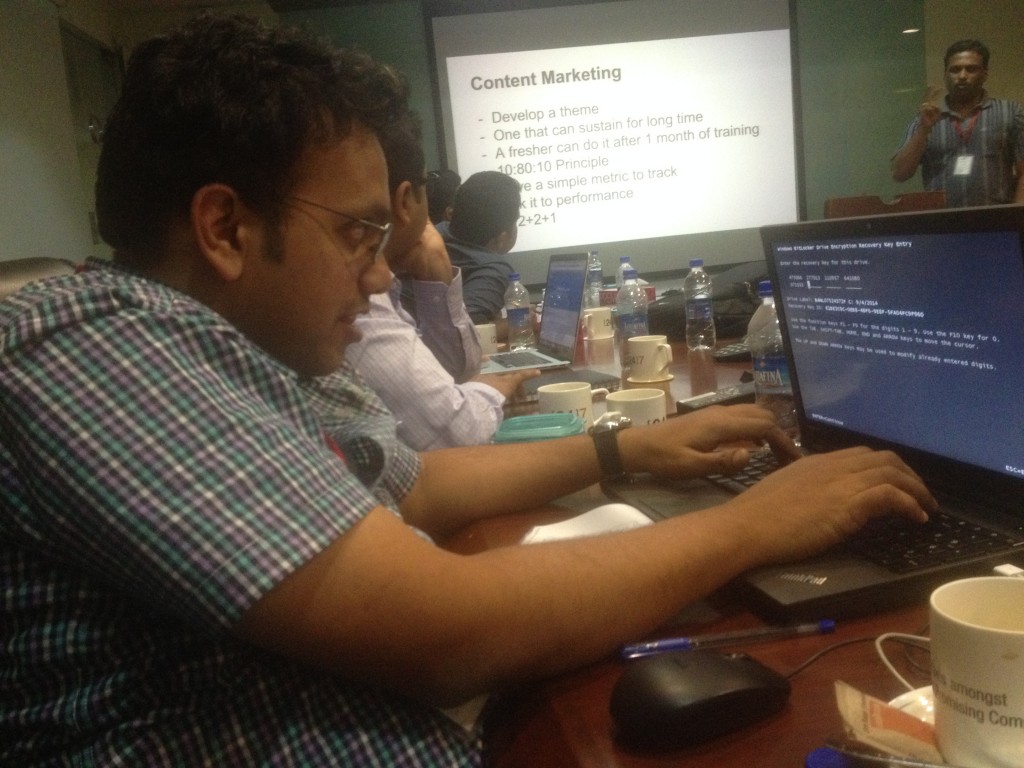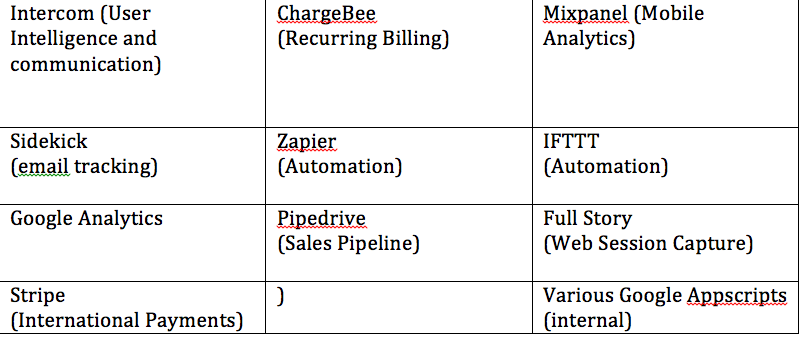iSPIRT kicked off its first roundtable for 2015 on 17th January at the office of Eko India, Gurgaon. The PlaybookRT was led by Deepak Prakash, Former VP of Sales at Tally Solutions. He has led building the entire sales network bottoms up and was the #1 sales person at Tally. Under him, Tally evolved from direct selling to single-tier home grown network for dominance and further evolved into a two tier network to create availability supplementing with all possible marketing activities with money/without money to reach-out to every potential buyer of our product(s).
The theme of the PlayBook Roundtable was something that poses a challenge for all tech entrepreneurs – Sales. Sales is what riddles most of the IT Product company start-ups – each one to his riddle. The intriguing problem of sales combined with Deepak’s experience and expertise in this subject ensured we had a full house on cold Saturday morning.
 Overview
Overview
There are roughly about 1.25 crore SMEs in India, and about 40 Lakh of them have computers and are ready for automation. This provides a huge opportunity for enterprise software providers. Most of tech entrepreneurs have built interesting products to address this large market, however sales has always been the Achilles’ heels. Deepak broadly outlined the following sales strategies to tackle this market.
Building an effective sales team
Understand the sales psyche
In order to build a successful sales team, it is imperative to understand the psyche of sales people. As tech entrepreneurs, we usually tend to apply the same yardstick for both technology folks and sales team. This approach is incorrect.
- Engineers and techies can accept failures easily, take it up as a challenge and build upon it. If there is a defect or something is not working, they will try new approaches to solve it. But for a sales guy, who is in front of a customer alone, failure can more often than not challenge his pride and ego. It needs a lot of effort for a sales person to swallow this failure and start afresh next morning. Inorder to keep his motivation high, it is necessary that we celebrate small sales victories and communicate the role he is playing in the organization.
- Developers and tech teams go by logic and enjoy data, analytics and whatsapp/SMS. While sales teams enjoy phone call over IM and there is more emotion in place. It is very easy for a sales person to become lost or feel small in a tech setup. Entrepreneurs need to work and ensure that both teams understand each other’s importance.
Hiring A Sales Team
In response to a question on what traits we should look for while hiring for a sales position, Deepak mentioned:
- The person should be able to make the customer comfortable and make him speak about his problems and needs. Only if a sales person can understand the pain point of customer, can he suggest the right value proposition. Someone who talks a lot and does not let others talk is not necessarily a good sales person.
- A good sales person will typically have his pipeline on tips of his fingertips. He should be able to spell this out at any time.
- Someone who says I can sell anything and I don’t need to know the product is a person you want to avoid. Because as an entrepreneur you want him to focus on product demo, and confide in the fact that your product is good enough that sale will happen if the right message goes to the customer.
In response to comments that it is difficult to find sales people who are ambitious or motivated, Sumit Kapoor from Employwise mentioned that it is not entirely correct. It is for the leader to inspire their people. We are able to inspire and motivate tech people easily but not sales people.
However, before hiring a sales team, founders need to ensure that the product or startup is at a stage where someone else can do the sales for them. E.g. if the sales calls become repetitive, you know that our sales process and collateral are ready for delegation.
Sales Team Training and Measuring Success
Deepak also shared his approach of measuring the success of sales teams:
- Do not measure the success of a sales person by the number of cheques he gets but by the number of demos he makes. As an entrepreneur, we need to believe that our product is good and so if the sales person focuses on a good demonstration, cheques will come and business will happen.
- The target or objective for sales team should be to talk about your passion, your innovation and your pride.
- We need to understand the dream of sales people. Rather than imposing our dream on them, if we start worrying about their dream, they will start worrying about yours.
The discussion then meandered into how to train and motivate your sales team. Everyone one chimed in with interesting thoughts and here are some of them:
- The first sales call for a new joinee is like sending a child to school. As parents we have to hold their hands and be there at the background. In case we close sale, do not ever say that sales happened because of me. Motive the new member and make him feel that he was the one who closed the deal.
- In technology, we attempt to solve problems that are under your control, while sales depend on other people (end user, decision maker and several stakeholders) and so we have to be patience and cut the sales team some slack.
- The only fear that sales folks have on the road is that sale will not happen. With every rejection, they lose a bit of self esteem. They have to recover from this loss over the night and get ready for a new day and a new fight. And on top of it, we as organizations impose tools such as CRM they have to fill in. These CRMs do not talk back and understand their feeling. At Tally Deepak used to call his boys everyday at 7 pm and hear them out, giving them a chance to vent out their feelings.
- In a tech company, usually a sales person is considered an outsider. But if the rest of the team starts seeing as a bread winner and if the sales person gets a feeling that the team depends on him, this will give him a high.
- As entrepreneurs, we also need to understand the difference between entrepreneurs and employees. Employees live for a lifestyle while entrepreneurs live for building an organization. Employees will plan for vacation, holidays etc. and we need to appreciate this.
- Normally we give just product training to sales teams but customers usually want to talk to someone who understands them. So domain knowledge becomes important.
- We try to surround sales people with tools such as CRM citing terms such as productivity, efficiency etc. These terms more often than not are Greek to them and they feel you are trying to control them, while the feeling inside them is freedom. We have to explain them to them that the tool is for liberation so that they start enjoying it.
 Digital vs. Feet on Street
Digital vs. Feet on Street
The discussion also got into choosing between Digital and Foot on Street and whether startups should try both. Sumeet opined that it is best not to get into a situation where we do both.
- A digital strategy takes time to build as you have to create content, online brand etc. that does not happen overnight.
- You also need to ensure that your customers are comfortable going through the entire sales cycle digitally including making payments. If there is any trade deficit, digital may not work.
- While building your digital content strategy, you also need to ensure whether your target SMEs are coming online to search for data. Do they have enough time or knowledge on how some of their problems will be solved.
While if you are going for feet on street, you need to remember to bring in processes that will help you scale. E.g. you have to build a sales engine through which if you run a new hire, he can go and sell your product.
Sometimes combining both digital and feet on street can mask problems in either of the approaches. E.g. if customers are not comfortable making payments online, we get our sales team to talk to them and make payments offline. This prevents us from addressing the real problem, which perhaps could be a trade deficit.
Building a Channels Strategy
The mantra of success was that they created their own channel network, this lead to a dedicated network which will take all the products Tally would have created or will create. They ensured that their channel has enough activity to do, opportunity to encash and inclusive work for their growth was charted.
Channel works well when people already know your brand. There are three major things that channels can help you with:
- Sell your product
- Act as fulfilment centres for your product
- Extension of network for messaging
Your channel strategy also has to evolve in-time. When you want to create deeper reach and availability you need to recruit another set of partners, and in parallel ensure that the already present channel also gains from your expansion.
Channel strategy has changes considerably between pre MNC and post MNC. Earlier there was a lot of relationship building, but now most of the channel partners play around very low margins. Entrepreneurs need to be wary of which strategy they want to adopt here.
Bundling Your Products
Another strategy tried by several companies is to bundle the product with another product that sells more. FMCG industry has done it very successfully. A couple of things that need to be taken care when pursuing this path are:
- The product you are bundling with should resonate with your own product. E.g. both products can complete each other
- Are the sales people selling the original product understand your product or are able to explain to customers about your products.
Referrals
Referrals are another avenue that startups can explore, however before doing so you need to ensure that you are capable to handle all the leads that come in. Throwing a bigger net that you can manage can actually backfire for you.
Right Business Model
Several SaaS based business have a monthly model where they would call businessmen every month to pay. This may not work well with SMEs. Your customer’s business is not to buy software with you. He would rather want to concentrate on his business. Hence it may make more sense to opt for an annual model. The serious customers will anyways buy this. Exotel had a similar experience.
Reaching out to different stakeholders
Often in an B2B setup, the user, decision maker and paying authority are different. The discussion moved to what should be the order in which different stakeholders are reached out. Usually sales team members are hesitant to meet the owner as they face the possibility of heavy rejection. Also owners are not interested in features but in how the tool can either help them save money or make more. However, they do depend on feedback from the user or beneficiary. Hence the sales team should first reach out to the user or beneficiary and then the owner. Sometimes the owner also depends on inputs from a Subject Matter Expert, who could be an IT guy or engineer in his friend/family and sometimes others (e.g. CAs in case of Tally)
However, in case of channels the approach is opposite. You first reach out to the owner to get them buy your proposition. Following this you want to reach out to the sales team of the partner so that they are well educated and trained to sell or demo your product.
 Monopolistic Market
Monopolistic Market
Dinesh Agarwal from Busy Software shared insights on how they penetrated a market which was dominated by one large player – Tally. He banked on users and stakeholders in accounting software to identify niche features that were required by a segment but not offered by Tally. One of such feature was statuary compliance. They launched this feature at half the price and this helped them penetrate. They also carved out their channel strategy and ecosystem that helped to build a strong market base.
Going International
Deepak also touched upon some key considerations while eyeing international sales:
- Your product will need to be adapted to the particular market you intend to tap into. It could be for example statuary compliance or local language support.
- International markets can be expensive and hence you need to plan well
- From a sales strategy, there will be broad similarities. E.g. international markets also have channels that work on the same motivations and contours.
- You need to accept the fact that no one in a new market knows you or your product. So if you start from scratch.
- The business problems and challenges are similar in different markets. They too have similar HR problems or business problems.
- There also needs to be a culture adoption, especially the way you communicate or conduct your sales effort.
- Before starting to build a channel in an international market, it usually makes sense that you acquire the first 10-20 customers yourself. This will help you understand the market better, ensure your product is ready and help you exploit the channel strategy much better.
- Set clear expectations and objectives so that you know when to get out if things are not working.
Conclusion
One thing that stood clear from inputs of all participants was that there is no size that fits all. Different solutions and strategies yielded results for different teams and entrepreneurs. It is imperative not to wear someone else’s stripes. Pick up a strategy that is doable for you based on the types of person you are and situation you are in.
 The high level of interest and engagement from all participants was evident as the session that planned for 3-4 hours got extended to beyond 7 hours. We finally concluded our first Roundtable for 2015 with a promise from Deepak that he will back with us in a couple of months.
The high level of interest and engagement from all participants was evident as the session that planned for 3-4 hours got extended to beyond 7 hours. We finally concluded our first Roundtable for 2015 with a promise from Deepak that he will back with us in a couple of months.


 Advertisers are predicted to spend close to
Advertisers are predicted to spend close to  Most every entrepreneur does things initially that don’t scale, and that’s okay to start. Pretty soon they realize that the things that made them successful enough to get initial sales and customers wont work for them to reach the next level at their startup.
Most every entrepreneur does things initially that don’t scale, and that’s okay to start. Pretty soon they realize that the things that made them successful enough to get initial sales and customers wont work for them to reach the next level at their startup. According to
According to 


 Overview
Overview Digital vs. Feet on Street
Digital vs. Feet on Street Monopolistic Market
Monopolistic Market The high level of interest and engagement from all participants was evident as the session that planned for 3-4 hours got extended to beyond 7 hours. We finally concluded our first Roundtable for 2015 with a promise from Deepak that he will back with us in a couple of months.
The high level of interest and engagement from all participants was evident as the session that planned for 3-4 hours got extended to beyond 7 hours. We finally concluded our first Roundtable for 2015 with a promise from Deepak that he will back with us in a couple of months.
 But there is one gentleman (or a brand, however you choose to see him) who has consistently been so good at product marketing, that it would be a shame not to try to learn from him. Chetan Bhagat has been so good at selling books that several of our more established, critically acclaimed (and might I say, better) writers have had to go into therapy to treat their egos. He single handedly changed publishing in India, and though his methods may be suspect, they are nothing if not effective.
But there is one gentleman (or a brand, however you choose to see him) who has consistently been so good at product marketing, that it would be a shame not to try to learn from him. Chetan Bhagat has been so good at selling books that several of our more established, critically acclaimed (and might I say, better) writers have had to go into therapy to treat their egos. He single handedly changed publishing in India, and though his methods may be suspect, they are nothing if not effective. Product Market Fit
Product Market Fit SEO
SEO
 Tools
Tools